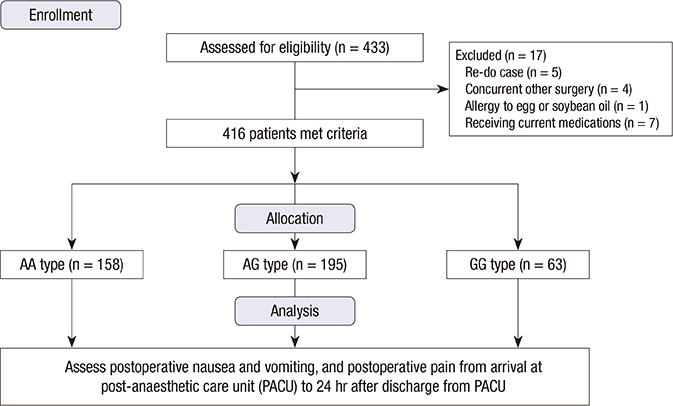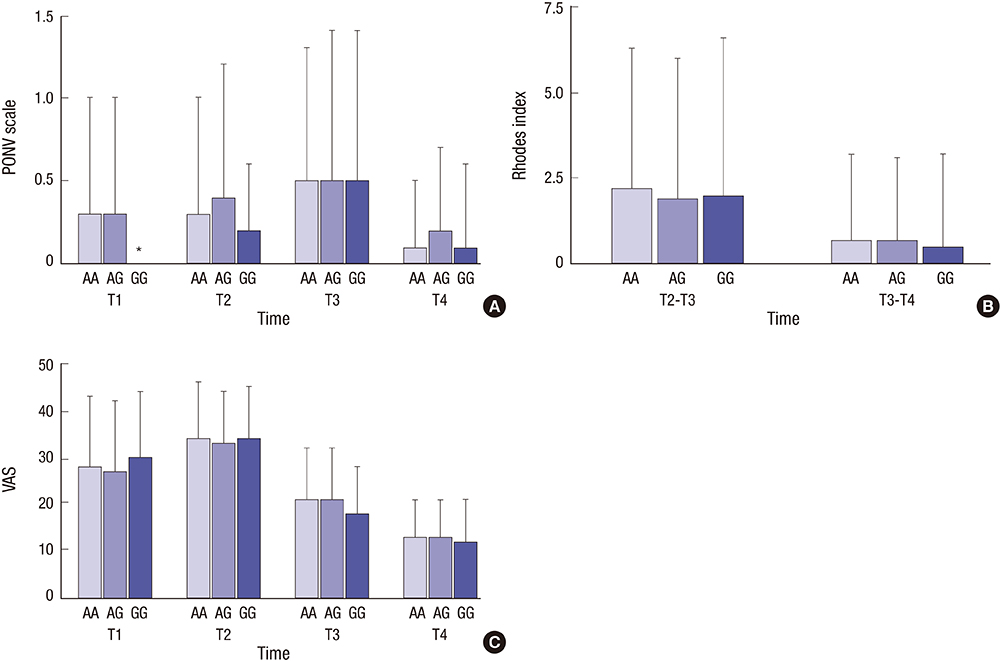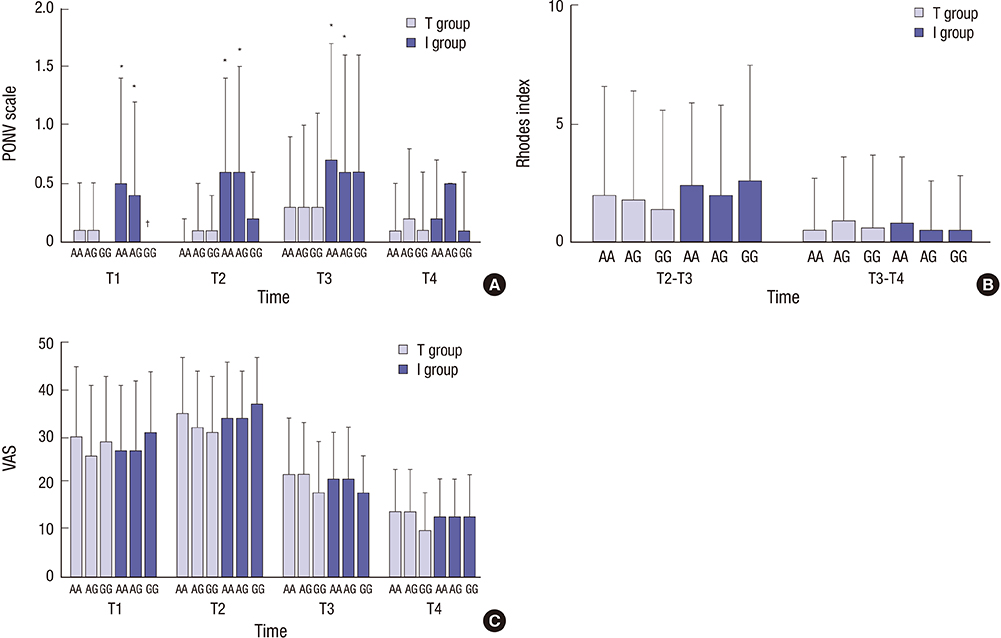J Korean Med Sci.
2015 May;30(5):651-657. 10.3346/jkms.2015.30.5.651.
Effects of micro-Opioid Receptor Gene Polymorphism on Postoperative Nausea and Vomiting in Patients Undergoing General Anesthesia with Remifentanil: Double Blinded Randomized Trial
- Affiliations
-
- 1Department of Microbiology, Konkuk University School of Medicine, Seoul, Korea.
- 2Department of Anesthesiology and Pain Medicine, Konkuk University Medical Center, Konkuk University School of Medicine, Seoul, Korea. yshkim75@daum.net
- 3Institute of Biomedical Science and Technology, Konkuk University School of Medicine, Seoul, Korea.
- KMID: 2155481
- DOI: http://doi.org/10.3346/jkms.2015.30.5.651
Abstract
- Association between postoperative nausea and vomiting (PONV) and micro-opioid receptor A118G single nucleotide polymorphism (SNP) is undefined and might underlie inconsistent results of studies on PONV occurrence in patients undergoing general anesthesia with the opioid, remifentanil. Four hundred and sixteen Korean women undergoing breast surgery with general anesthesia were randomized to receive remifentanil 10 ng/mL (plasma-site, Minto model) using a target-controlled infusion device and either propofol for total intravenous anesthesia (T group) or sevoflurane for inhalation anesthesia (I group) with bispectral index values maintained between 40 and 60. Blood specimens were collected after anesthesia induction for A118G SNP analysis. PONV and postoperative pain were evaluated. A118G SNP type distribution among Korean female adults studied was AG (n=195)>AA (n=158)>GG (n=63). Regardless of anesthetic technique, patients with GG types had lower PONV scale on arrival at postoperative care unit (PACU) (P=0.002), while T group showed lower PONV scale than I group up to 6 hr after PACU discharge in AA and AG types. No differences were apparent for postoperative pain among opioid receptor polymorphism. PONV occurrence differs according to opioid receptor polymorphism and anesthetic technique in patients undergoing general anesthesia with remifentanil.
Keyword
MeSH Terms
-
Adult
Analgesics, Opioid/*adverse effects
Anesthesia, General/*adverse effects
Breast Diseases/surgery
Demography
Double-Blind Method
Female
Humans
Methyl Ethers/adverse effects/therapeutic use
Pain, Postoperative/drug therapy
Piperidines/*adverse effects/therapeutic use
*Polymorphism, Single Nucleotide
Postoperative Nausea and Vomiting/*etiology
Receptors, Opioid, mu/*genetics
Analgesics, Opioid
Methyl Ethers
Piperidines
Receptors, Opioid, mu
Figure
Cited by 2 articles
-
Mu-Opioid Receptor Polymorphisms and Breast Cancer in a Korean Female Adult Population: A Retrospective Study
Chung-Sik Oh, Seung-Hyun Lee, Young-Bum Yoo, Jung-Hyun Yang, Seong-Hyop Kim
J Breast Cancer. 2016;19(2):206-209. doi: 10.4048/jbc.2016.19.2.206.The Influence of Genotype Polymorphism on Morphine Analgesic Effect for Postoperative Pain in Children
Mi Geum Lee, Hyun Jung Kim, Keun Hwa Lee, Yun Suk Choi
Korean J Pain. 2016;29(1):34-39. doi: 10.3344/kjp.2016.29.1.34.
Reference
-
1. Stadler M, Bardiau F, Seidel L, Albert A, Boogaerts JG. Difference in risk factors for postoperative nausea and vomiting. Anesthesiology. 2003; 98:46–52.2. Eikaas H, Raeder J. Total intravenous anaesthesia techniques for ambulatory surgery. Curr Opin Anaesthesiol. 2009; 22:725–729.3. Ahn HJ, Chung SK, Dhong HJ, Kim HY, Ahn JH, Lee SM, Hahm TS, Kim JK. Comparison of surgical conditions during propofol or sevoflurane anaesthesia for endoscopic sinus surgery. Br J Anaesth. 2008; 100:50–54.4. Coskun D, Celebi H, Karaca G, Karabiyik L. Remifentanil versus fentanyl compared in a target-controlled infusion of propofol anesthesia: quality of anesthesia and recovery profile. J Anesth. 2010; 24:373–379.5. Juckenhöfel S, Feisel C, Schmitt HJ, Biedler A. TIVA with propofol-remifentanil or balanced anesthesia with sevoflurane-fentanyl in laparoscopic operations. Hemodynamics, awakening and adverse effects. Anaesthesist. 1999; 48:807–812.6. Morino R, Ozaki M, Nagata O, Yokota M. Incidence of and risk factors for postoperative nausea and vomiting at a Japanese Cancer Center: first large-scale study in Japan. J Anesth. 2013; 27:18–24.7. Rama-Maceiras P, Ferreira TA, Molins N, Sanduende Y, Bautista AP, Rey T. Less postoperative nausea and vomiting after propofol + remifentanil versus propofol + fentanyl anaesthesia during plastic surgery. Acta Anaesthesiol Scand. 2005; 49:305–311.8. Mukherjee K, Seavell C, Rawlings E, Weiss A. A comparison of total intravenous with balanced anaesthesia for middle ear surgery: effects on postoperative nausea and vomiting, pain, and conditions of surgery. Anaesthesia. 2003; 58:176–180.9. Del Gaudio A, Ciritella P, Perrotta F, Puopolo M, Lauta E, Mastronardi P, De Vivo P. Remifentanil vs fentanyl with a target controlled propofol infusion in patients undergoing craniotomy for supratentorial lesions. Minerva Anestesiol. 2006; 72:309–319.10. Gaszynski TM, Strzelczyk JM, Gaszynski WP. Post-anesthesia recovery after infusion of propofol with remifentanil or alfentanil or fentanyl in morbidly obese patients. Obes Surg. 2004; 14:498–503. discussion 4.11. Landau R, Bollag LA, Kraft JC. Pharmacogenetics and anaesthesia: the value of genetic profiling. Anaesthesia. 2012; 67:165–179.12. Marsh B, White M, Morton N, Kenny GN. Pharmacokinetic model driven infusion of propofol in children. Br J Anaesth. 1991; 67:41–48.13. Minto CF, Schnider TW, Egan TD, Youngs E, Lemmens HJ, Gambus PL, Billard V, Hoke JF, Moore KH, Hermann DJ, et al. Influence of age and gender on the pharmacokinetics and pharmacodynamics of remifentanil. I. Model development. Anesthesiology. 1997; 86:10–23.14. Minto CF, Schnider TW, Shafer SL. Pharmacokinetics and pharmacodynamics of remifentanil. II. Model application. Anesthesiology. 1997; 86:24–33.15. Gómez-Hernández J, Orozco-Alatorre AL, Domínguez-Contreras M, Oceguera-Villanueva A, Gómez-Romo S, Alvarez Villaseñor AS, Fuentes-Orozco C, González-Ojeda A. Preoperative dexamethasone reduces postoperative pain, nausea and vomiting following mastectomy for breast cancer. BMC Cancer. 2010; 10:692.16. Rhodes VA, McDaniel RW. The Index of Nausea, Vomiting, and Retching: a new format of the lndex of Nausea and Vomiting. Oncol Nurs Forum. 1999; 26:889–894.17. Kim KM, Kim HS, Lim SH, Cheong SH, Choi EJ, Kang H, Choi HR, Jeon JW, Yon JH, Oh M, et al. Effects of genetic polymorphisms of OPRM1, ABCB1, CYP3A4/5 on postoperative fentanyl consumption in Korean gynecologic patients. Int J Clin Pharmacol Ther. 2013; 51:383–392.18. Zhang W, Yuan JJ, Kan QC, Zhang LR, Chang YZ, Wang ZY. Study of the OPRM1 A118G genetic polymorphism associated with postoperative nausea and vomiting induced by fentanyl intravenous analgesia. Minerva Anestesiol. 2011; 77:33–39.19. Sia AT, Lim Y, Lim EC, Goh RW, Law HY, Landau R, Teo YY, Tan EC. A118G single nucleotide polymorphism of human mu-opioid receptor gene influences pain perception and patient-controlled intravenous morphine consumption after intrathecal morphine for postcesarean analgesia. Anesthesiology. 2008; 109:520–526.20. Kim SH, Oh CS, Yoon TG, Cho MJ, Yang JH, Yi HR. Total intravenous anaesthesia with high-dose remifentanil does not aggravate postoperative nausea and vomiting and pain, compared with low-dose remifentanil: a double-blind and randomized trial. ScientificWorldJournal. 2014; 2014:724753.21. Chandrakantan A, Glass PS. Multimodal therapies for postoperative nausea and vomiting, and pain. Br J Anaesth. 2011; 107:i27–i40.22. Chou WY, Yang LC, Lu HF, Ko JY, Wang CH, Lin SH, Lee TH, Concejero A, Hsu CJ. Association of mu-opioid receptor gene polymorphism (A118G) with variations in morphine consumption for analgesia after total knee arthroplasty. Acta Anaesthesiol Scand. 2006; 50:787–792.23. Chou WY, Wang CH, Liu PH, Liu CC, Tseng CC, Jawan B. Human opioid receptor A118G polymorphism affects intravenous patient-controlled analgesia morphine consumption after total abdominal hysterectomy. Anesthesiology. 2006; 105:334–337.24. Ogurlu M, Sari S, Kucuk M, Bakis M, Ugur B, Eshraghi YE, Galimberti F, Turan A. Comparison of the effect of propofol and sevoflurane anaesthesia on acute and chronic postoperative pain after hysterectomy. Anaesth Intensive Care. 2014; 42:365–370.25. Song JG, Shin JW, Lee EH, Choi DK, Bang JY, Chin JH, Choi IC. Incidence of post-thoracotomy pain: a comparison between total intravenous anaesthesia and inhalation anaesthesia. Eur J Cardiothorac Surg. 2012; 41:1078–1082.26. Bond C, LaForge KS, Tian M, Melia D, Zhang S, Borg L, Gong J, Schluger J, Strong JA, Leal SM, et al. Single-nucleotide polymorphism in the human mu opioid receptor gene alters beta-endorphin binding and activity: possible implications for opiate addiction. Proc Natl Acad Sci U S A. 1998; 95:9608–9613.
- Full Text Links
- Actions
-
Cited
- CITED
-
- Close
- Share
- Similar articles
-
- Effects of Supplemented Remifentanil/Meperidine to Sevoflurane Anesthesia on the Recovery in the Pediatrics Undergoing Tonsillectomy
- Comparison of ramosetron and ondansetron for preventing nausea and vomiting after middle ear surgery under general anesthesia with sevoflurane and remifentanil
- Effects of opioid-sparing general anesthesia on postoperative nausea and vomiting in laparoscopic gynecological surgery
- Efficacy of Ramosetron for the Prevention of Nausea and Vomiting after Thyroidectomy
- Remifentanil used as adjuvant in general anesthesia for spinal fusion does not exhibit acute opioid tolerance




